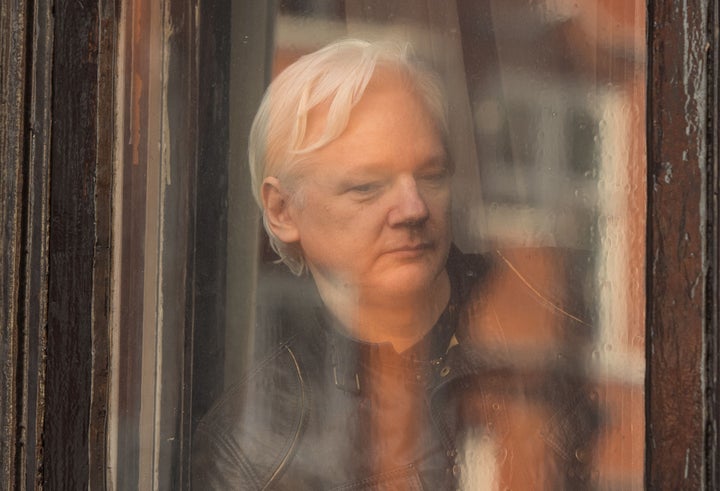Julian Assange still faces arrest if he leaves the Ecuadorian embassy in London after a court ruled a warrant against him was still valid.
The WikiLeaks founder applied to have the warrant for skipping bail quashed, which would free him to leave the embassy, after hiding there from arrest since June 2012.
Westminster Magistrates’ Court previously heard the 46-year-old was suffering from depression, a frozen shoulder and painful toothache after five and a half years without access to medical treatment.
He claimed being extradited to Sweden could see him removed to the US over WikiLeaks’ publication of war logs and diplomatic cables.

Swedish prosecutors had already dropped their investigation over sexual assault and rape allegations, which he denies.
Assange’s lawyer Mark Summers had previously told the court the bail arrest warrant had “lost its purpose and its function” when Sweden withdrew the European Arrest Warrant (EAW).
On Tuesday, Chief Magistrate Emma Arbuthnot said legal precedents “underline the importance of a defendant attending court when bail to do so,” adding: “I am not persuaded that the warrant should be withdrawn.”
She added it was “not uncommon” for people to be pursued for bail offences after the proceedings the bail related to were discontinued.
Assange tweeted to condemn “wall to wall fake news stating the government won today’s hearing”, insisting his legal team was still fighting the warrant on other grounds.
AAfter her ruling on Tuesday afternoon, the magistrate heard submissions from Assange’s lawyers, who argued it was not in the public interest to pursue the case against him.
She is due to make a further ruling on these on February 13.
Assange’s lawyer Jen Robinson said: “This case is and has always been about the risk of extradition to the United States and that risk remains real. Nobody can credibly deny that.”
Assange walked into the embassy seeking asylum after he fought extradition through the English courts.
His time there has been marked by regular appearances at the embassy’s balcony to address crowds of supporters, who have gathered at various stages of his legal battle.

For three years, the Metropolitan Police maintained a permanent guard outside the embassy in case he left, but stopped this in 2015, citing the cost.
In 2016, a UN panel called on Swedish and British authorities to end Assange’s “deprivation of liberty”.
The Foreign Office condemned this, saying it “completely rejects any claim that Julian Assange is a victim of arbitrary detention”.
It added Assange was “in fact, voluntarily avoiding lawful arrest by choosing to remain in the Ecuadorean embassy”.
Julian Assange: How he ended up at Ecuadorian embassy
Assange was accused of rape and molestation by two women, who were unnamed WikiLeaks supporters, after a trip to Sweden in August 2010. Swedish prosecutors issued a warrant for his arrest in November, after he had left the country.
In December, Assange was arrested in London and bailed. He spent the next 18 months fighting extradition through the courts.
In May 2012, he suffered his final defeat when the Supreme Court ruled he should be extradited. Three weeks later, he stunned the world when he walked into the embassy seeking asylum.
This was granted in August but he still faced arrest if he left the embassy.
In August 2015, the charges of molestation and unlawful coercion were discontinued as they were subject to five-year statutes of limitations under Swedish law.
Assange still faced the more serious allegation of rape, which is subject to a 10-year limit.
But in May 2017, Swedish prosecutor Marianne Ny announced she was discontinuing this case as well.
“All possibilities to conduct the investigation are exhausted,” she said. “In order to proceed with the case, Julian Assange would have to be formally notified of the criminal suspicions against him.
“We cannot expect to receive assistance from Ecuador regarding this. Therefore the investigation is discontinued.”
Assange said he feared being sent to Sweden would mean a further extradition to the US to face charges over WikiLeaks’ leaking of military and diplomatic cables.
In May last year, Swedish prosecutor Marianne Ny said she was withdrawing the EAW because Assange’s refusal to come to Sweden meant “all possibilities to advance the investigation have now been exhausted”.
This meant bail warrant was the only thing keeping Assange in the embassy.
Before Tuesday’s ruling, a CPS spokesman said Assange would be able to leave the embassy if the warrant were lifted, adding: “Hypothetically yes, that would be our interpretation.”
Extradition lawyer Edward Grange said of Tuesday’s ruling: “Today’s decision results in a continuation of the impasse...
“The Metropolitan police will continue to be obliged to arrest Assange should he set foot outside the Embassy.”
